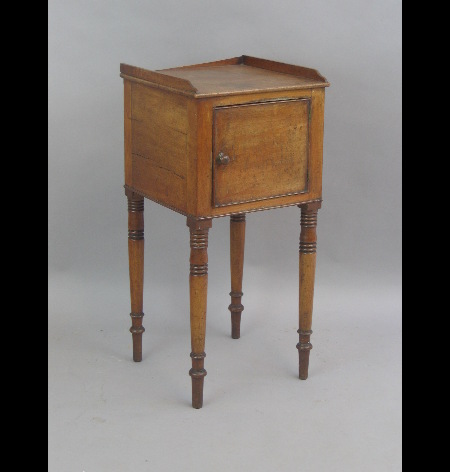A Victorian mahogany night watchman's tell-tale bracket clock or noctuary Unsigned but probably by Smith and Sons, London, mid 19th century The four pillar single chain fusee movement with anchor escapement regulated by lenticular bob pendulum and passing strike, the 5.25 inch circular silvered brass Roman numeral with steel hands set within recessed circular ring engraved with reversed Roman numeral chapters fitted with push-pins at every half-hour to circumference and rotating anticlockwise against a plunger positioned to the upper margin, the case of rectangular form with recessed brass carrying handle and plunger to top over hinged circular bevel glazed cast brass bezel flanked by canted angles and floral scroll carved decoration to lower corners, the sides with rectangular side windows over ogee-profile moulded rails, the rear with rectangular glazed door, on shallow skirt base with simple squab feet, 32cm (12.5cm) high excluding plunger; 37.5cm (14.75ins) high overall. An almost identical clock signed SMITH & SONS, CLERKENWELL was sold by Tennants, Leyburn on 16th March 2013 (lot 1189) for £650 hammer. The firm of John Smith and Sons was established in 1780 and became one of the largest manufacturers of both domestic and public clocks throughout the 19th century and is still trading today but as a materials stockholder and broker having made their last clock in 1938. The night watchman's clock or noctuary was developed as a 'tell-tale' method of recording a night watchman's progress throughout his shift. The dial incorporates a revolving ring to the circumference fitted with pins which are pushed-in by a manually operated plunger fitted to the exterior of the locked case. By having two such timepieces at each end of a watchman's circuit a record of his patrols throughout the night can be recorded. The pins are automatically reset to their raised position by a ramp positioned behind the ring at around the eleven o'clock position. The first basic design of 'Watchman's Noctuary' (see following lot) was subject of a patent submitted by Samuel Day in 1803 however the patent was disputed on the grounds that the Earl of Exeter had been using two such timepieces made by Boulton and Watt since 1799. Condition report disclaimer
A Victorian mahogany night watchman's tell-tale bracket clock or noctuary Unsigned but probably by Smith and Sons, London, mid 19th century The four pillar single chain fusee movement with anchor escapement regulated by lenticular bob pendulum and passing strike, the 5.25 inch circular silvered brass Roman numeral with steel hands set within recessed circular ring engraved with reversed Roman numeral chapters fitted with push-pins at every half-hour to circumference and rotating anticlockwise against a plunger positioned to the upper margin, the case of rectangular form with recessed brass carrying handle and plunger to top over hinged circular bevel glazed cast brass bezel flanked by canted angles and floral scroll carved decoration to lower corners, the sides with rectangular side windows over ogee-profile moulded rails, the rear with rectangular glazed door, on shallow skirt base with simple squab feet, 32cm (12.5cm) high excluding plunger; 37.5cm (14.75ins) high overall. An almost identical clock signed SMITH & SONS, CLERKENWELL was sold by Tennants, Leyburn on 16th March 2013 (lot 1189) for £650 hammer. The firm of John Smith and Sons was established in 1780 and became one of the largest manufacturers of both domestic and public clocks throughout the 19th century and is still trading today but as a materials stockholder and broker having made their last clock in 1938. The night watchman's clock or noctuary was developed as a 'tell-tale' method of recording a night watchman's progress throughout his shift. The dial incorporates a revolving ring to the circumference fitted with pins which are pushed-in by a manually operated plunger fitted to the exterior of the locked case. By having two such timepieces at each end of a watchman's circuit a record of his patrols throughout the night can be recorded. The pins are automatically reset to their raised position by a ramp positioned behind the ring at around the eleven o'clock position. The first basic design of 'Watchman's Noctuary' (see following lot) was subject of a patent submitted by Samuel Day in 1803 however the patent was disputed on the grounds that the Earl of Exeter had been using two such timepieces made by Boulton and Watt since 1799. Condition report disclaimer















Try LotSearch and its premium features for 7 days - without any costs!
Be notified automatically about new items in upcoming auctions.
Create an alert